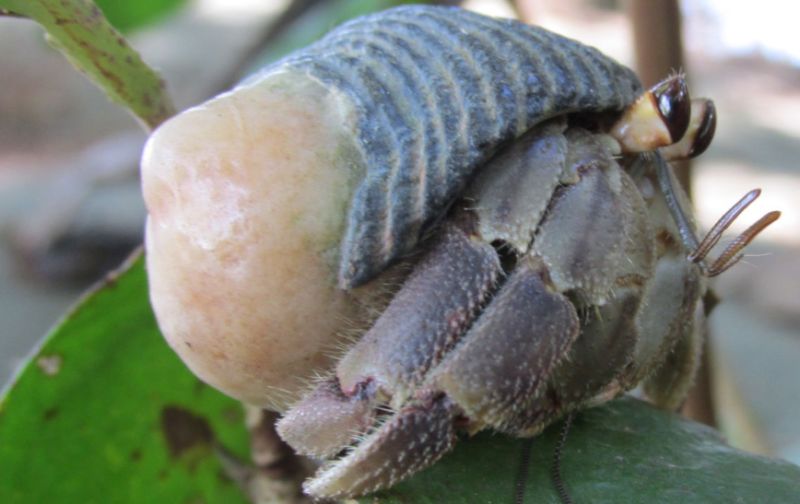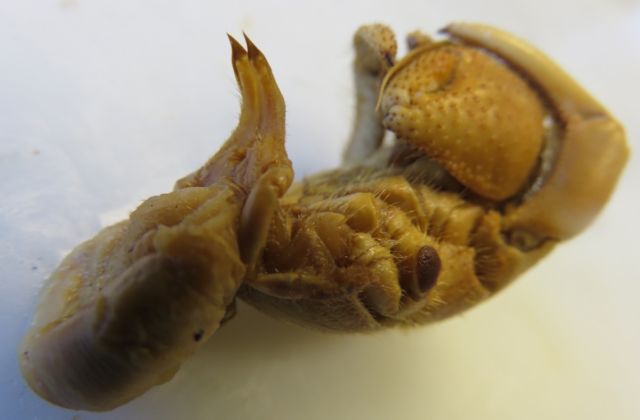
Hermit crabs protect their soft, curved abdomens from harm by scavenging seashells and turning them into portable homes. That poses a challenge when it comes time to mate, since a rival can steal the shell while its occupant is, shall we say, otherwise occupied. A new paper in the journal Royal Society Interface poses an intriguing new hypothesis: some species of male hermit crabs evolved substantially longer penises so they could mate without having to venture too far outside their shells.
Mark Laidre, a biologist at Dartmouth College in New Hampshire, dubbed his hypothesis "private parts for private property." He's been studying the behavior of a particular species of hermit crab, Coenobita compressus, for the last decade.
Seashells are a valuable, limited resource—a kind of private property for hermit crabs and their most prized possession. This is particularly true for Coenobita compressus. This species engages in elaborate remodeling of scavenged shells to tailor them precisely to their liking, tearing out hard material inside the shell over several months to make more room for their bodies. Because the shells are so valuable, there is stiff competition to attain a really nice shell. Fights break out, crabs will kill another crab for their shells, and sometimes the beasts will just outright steal them. Since the remodeled shells prevent the creatures from drying out (which can happen within 24 hours), they are crucial to the crabs' survival.

Laidre drew inspiration for his study from none other than Charles Darwin, who marveled at barnacles, which boast the largest penises in the animal kingdom relative to their body size. "When fully extended, it must equal between eight and nine times the entire length of the animal," he wrote in an 1854 monograph. Darwin reasoned that the barnacles evolved this attribute so that they would be better able to inseminate more distant neighboring barnacles.
Laidre thinks a similar selective effect led to larger penis size in hermit crabs. "In theory, longer penises could enable individuals to reach out to sexual partners while simultaneously maintaining a safe grip on their property with the rest of the body, thus safeguarding property against thieves while having sex," he wrote. If true, that would mean that larger penis size relative to body size would be found in hermit crab species that extensively remodel their shells compared to hermit crab species that do not remodel their shells. And those who do not remodel their shells should, in turn, have significantly larger penises than species that don't carry shells at all.
To collect evidence in support of his hypothesis, Laidre compared hundreds of specimens of nine related hermit crab species preserved in ethanol at the Smithsonian Institute in Washington, DC, and the Harvard Museum of Comparative Zoology in Cambridge, Massachusetts. He measured their "sexual tubes" with electronic calipers, then calculated the ratio of body size to penis size for every specimen. (The tubes are hardened protrusions that function as a penis in males, since they contain ducts for ejaculating semen into a female's shell.)

The data support Laidre's hypothesis. Coenobita compressus had the largest penis-to-body-size ratio (more than 0.6) among the specimens—still minuscule compared to the mighty barnacle, but we're grading on a curve here. A close relative known as Coenobita perlatus only does a little shell remodeling, and it has a ratio of about 0.5, which is still larger than that of Coenobita clypeatus, which hardly remodels its shell at all and whose penis is about one-third its body length.
And then there is the coconut crab, a species that can grow up to nine pounds and only use shells as juveniles. The abdomens of coconut crabs re-calcify as they age, so they have no need of protective shells when fully mature. Coconut crabs have the tiniest penises of all, less than 20 percent of their body size. Lairdre suggests that this species of crab has no risk of losing its private property and thus natural selection did not endow it with enhanced penis size.
Lairdre hopes that his hypothesis might be more general, extending to other species besides hermit crabs. "Obviously, most other species are not literally using shells, but they do have external resources that are not part of their body," he told The Scientist. "There are things that are valuable and that they're trying to defend. What's intriguing about this hypothesis is that the core of it is that there's an inherent tradeoff in evolution between devoting resources to one thing and devoting resources to another."
DOI: Royal Society Open Science, 2019. 10.1098/rsos.181760 (About DOIs).
reader comments
127